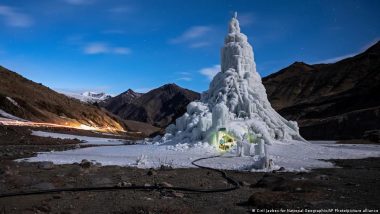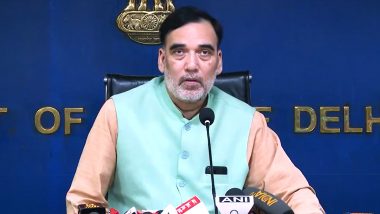As rising temperatures cause glaciers around the world to recede, some countries are bolstering water supply by making their own.About 1.9 billion people around the world rely on glaciers and snowpacks as a source of drinking water.
Also Read | Business News | BD Launches the TB Guardianship Program.
As glaciers undergo a normal process of melting during the year's warmer months, they steadily pour vast quantities of water into rivers, sustaining humans, industry, and ecosystems. But to be able to do this, glaciers have to replenish at a similar rate during winter months when snow falls.
Also Read | World News | Pakistan: Nawaz Sharif’s PML-N Reschedules General Council Meeting.
Yet as global temperatures rise and rainfall patterns change, the system has been thrown off. Now the world's glaciers are shrinking by 1.2 trillion tons of ice a year. Even if humanity can limit global warming to 1.5 degrees Celsius (2.7 degrees Fahrenheit), half of the world's mountain glaciers could disappear by 2100.
One of the world's most vulnerable areas is the Indus basin, which provides water to at least 250 million people in Afghanistan, China, India, and Pakistan.
But one group in the Himalayas, the Students' Educational and Cultural Movement of Ladakh (SECMOL), says it has found a solution — growing artificial glaciers.
What is an artificial glacier?
Stories of artificial glaciers go back to at least the 13th century AD, when according to legend, the residents of modern-day Pakistan seeded glaciers in key mountain passes to block the approach of Genghis Khan's marauding army. For centuries, communities in the Hindu Kush and Karakoram mountain ranges have created rudimentary glaciers to strengthen water supplies.
More recently in the 1990s, as glaciers retreated further up the mountains in India's cold desert mountain region of Ladakh, important meltwater started arriving later in the growing season, causing problems for water-sensitive staple crops. In response, local engineers started creating artificial glaciers that would counter water shortages by melting earlier and more reliably.
One of the techniques used required the construction of a series of cascades on perennial rivers to allow ice to accumulate on the exposed surfaces. Large streams can also be diverted into smaller streams that are shaded by mountains and then freeze over. Another option is to build massive basins and fill them up in fall to slowly freeze. The important Himalayan city of Leh relies on one of these.
When the stored ice melts, they provide an important water source for farmers in the sowing months of April and May, before the rivers start fully flowing again in June.
However, these approaches can be unreliable due to susceptibility to flash floods, landslides, erosion, and sedimentation. Reconstruction efforts after such problems can be enormously taxing for villagers, and often coincide with labor demands for agriculture.
To address these concerns, a new technique was developed — the ice stupa, a large cone of ice that looks vaguely like Buddhist ceremonial burial mounds called stupas. Hence the name.
During the wet season, a gravity-fed underground pipe brings water from high-altitude streams down the valley. There it is sprayed into a vertical fountain at night, allowing the water to refreeze over a cone-shaped base. Stupas are built next to villages and are less prone to melting due to their low surface area.
The large mounds of ice survive long after the surrounding area has melted, slowly releasing water over the spring and summer months.
The technique has since been adopted globally, with stupas popping up in Kyrgyzstan, Chile, Mongolia and other countries where they have proven to help villages with water supplies.
To what extent can artificial glaciers prevent water scarcity?
Because human-caused climate change is reducing snowfall in the mountains, the total amount of available water in those environments is not what it once was. Ice stupas can do nothing to remedy this. And scientists say as the world heats up, these artificial glaciers will ultimately suffer the same fate as their natural cousins.
A 2018 review of various ice reservoir projects found they could be helpful in specific local contexts but were a questionable solution to the overall problem of melting glaciers due to climatic variability, natural hazards, and socioeconomic issues.
The Ladakh projects have also suffered some backlash from villagers, who question the organization's right to draw water from the streams, as well as who gets to reap the benefits.
Proponents claim that the meltwater harvested would otherwise go to waste, but critics say the streams recharge springs that provide drinking water for the villages.
Are there other ways to prevent glaciers from receding?
Countries such as Switzerland and Italy have resorted to protecting their glaciers with giant blankets over summer. Another approach is to spray them with vast quantities of artificial snow to grow their size and reduce melting.
These both help, but only slow the inevitable. They also come with high price tags and heavy environmental tolls including plastic pollution and emissions from high energy use.
Experts agree that the most effective way to protect the world's cryosphere is by limiting climate change. And the best way to do that is to stop burning fossil fuels.
Edited by: Tamsin Walker
Sources:
Half of world's glaciers to 'disappear' with 1.5C of global warming, Carbon Brief, 2023
https://www.carbonbrief.org/half-of-worlds-glaciers-to-disappear-with-1-5c-of-global-warming/
Review article: Earth's ice imbalance, Copernicus, 2021
https://tc.copernicus.org/articles/15/233/2021/
Socio-hydrology of "artificial glaciers" in Ladakh, India: assessing adaptive strategies in a changing cryosphere, Regional Environmental Change, 2018
https://link.springer.com/article/10.1007/s10113-018-1372-0
(The above story first appeared on LatestLY on May 07, 2024 03:30 PM IST. For more news and updates on politics, world, sports, entertainment and lifestyle, log on to our website latestly.com).













 Quickly
Quickly












 GT
GT







